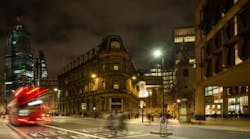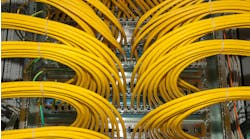Case Study: Smart lighting in urban canyons
By Phil Beecher, president & CEO of Wi-SUN Alliance
The one-square mile of the City of London might have been founded by Romans in the first century, but don’t be confused. This historical heart of England and the UK’s capital has put in place a smart lighting initiative that keeps the city vibrant and safe.
When Americans hear the term “the City of London” they immediately think of the largest city of England and the United Kingdom. Truth be told, the City of London is the oldest settlement in London and is a tiny, but important, part of the larger metropolis of London. Affectionately known as “the Square Mile” because it occupies just over that amount of space, or “the City”, the City of London is the historical heart of the capital and houses England’s financial district and commerce center. It also is known for its architecture, which combines old and new, as well as its medieval street pattern, full of narrow alleyways and streets.
The City of London is home to only 9,400 permanent residents, though on a busy day, nearly half a million people commute in either to work or to visit famous landmarks and tourist destinations such as the Tower of London and St. Paul’s Cathedral.
What makes the City of London so special is also what makes it challenging from a technology standpoint. Narrow alleys and old streets flanked by ancient and modern buildings create urban canyons that make communications connectivity a challenge. The City of London calls these “conflict areas” and uses street lighting to create a safe and thriving environment for residents and visitors alike.
With a desire to reduce costs and improve reliability and public safety, the City of London initiated a street-lighting initiative, which has evolved into a smart city that can compete with others around the world. Much of the City’s street light inventory was more than 30 years old and was no longer supported by UK Power Networks (UKPN) nor able to achieve the safety and vibrancy goals the City of London wanted to create.
Over the course of three years, starting in 2018, the City of London was able to create a flexible, interoperable communications infrastructure that allows for smart lighting. Working with the Wi-SUN Alliance, the City of London implemented a network that could, over time, also accommodate other smart-city devices, which could help the City reduce pollution and energy consumption, as well as manage its traffic and transport systems.
An ambitious project
As the City of London initiated its smart-lighting program, it became clear that its unique architecture and street layout created issues that needed to be overcome.
As Giles Radford, highways manager for the City of London says, “it felt like an ambitious project—with the architectural and structural challenges that the City presents, while putting in place a network that would meet our needs for lighting management and control, for example changing lighting levels when we needed and providing fault reporting.”
In addition to the functional element of lighting streets, road signs, bridges and tunnels, and floodlighting, there was an aesthetic element to the project: lighting the City’s iconic landmarks, fountains, trees and even providing seasonal festive lighting, all while being environmentally conscious. A Central Management System (CMS) and LEDs would be necessary to achieve this goal using tunable digital-lighting settings that are not easily achievable using analog lights. Adaptive visual design was a key requirement, but having control over the lighting stock was critical.
During the procurement process and trials, Radford and his team evaluated the Wi-SUN Alliance field area network (FAN). Wi-SUN FAN, a technical specification and certification program for large-scale outdoor IoT networks, supports millions of devices in smart cities around the world. It’s self-forming, self-healing mesh technology creates excellent network coverage, scalability, enterprise-grade security and reliable communications—even in the urban canyons that the City of London was working around.
“Wi-SUN FAN could support the level of control and management we needed through a CMS. But what really sold it to us was the fact that it is an open standards-based platform, allowing us to introduce other smart devices and sensors—for traffic and environmental monitoring, asset management and waste management—across a network that can provide key data to manage our assets.”
Converting legacy streetlights, many of which have been in place for decades, into a smart-lighting network has become an important part of this digital transformation process, and in many cases, the ‘entry point’ for city developers and local authorities when designing and planning a smart city. Because of this, the City of London officials had to take other programs into consideration, including real-time reporting in line with a service-based and strategic energy review, reduction in energy consumption to deliver financial savings and alignment to the wider Internet of Things (IoT) initiative.
A plan for the future
Having found a match with the Wi-SUN Field Area Network, the City of London partnered with Wi-SUN Alliance members, urbancontrol, the project’s systems integrator, Itron, a smart-utility technology company, and exterior lighting specialists, DW Windsor. Together they standardized about 45 different types of lighting.
Over a three-year period, the City of London replaced more than 12,000 lights in total including 9,500 streetlights, 1,300 road lights and 1,600 specials. With the old units replaced, the City’s carbon footprint and maintenance costs were reduced. According to the City of London Corporation, it has already saved 60% on its energy costs since the new installation was completed.
While the City of London street lighting initiative is now finished, it’s only part of its journey to become a smart city. It has plans to deliver additional applications and services in the future and is well equipped to do so with Wi-SUN’s FAN.



